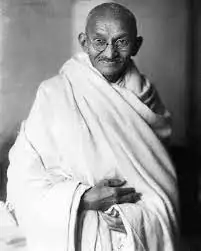Introduction#
100 years ago, India was one of a colonies of The Great Britain. Under the rule of the British, the Indians were discriminated and got massacred. Therefore, in 1919, Mahatma Gandhi started Satyagraha, also known as “Non-cooperation movement” in search of the independence of India.

The central concept of the movements were non-violent actions of fighting with the British government, such as not paying taxes, not going to public school, etc. Eventually, Gandhi was sent to prison because of these campaigns, but the government was forced to amend new law to let the Indians have more civil rights. Non-violent actions are good methods to win justice and protect people’s rights. Though during the movement of India independence, violent actions still happened a lot in the India. But it was still a good examples of how people fight with the unreasonable power, so did the Martin Luther King perform in the civil rights movements in 1960s. Hence, the successful non-violent actions should be practiced in the first place, which could be performed in many ways and a variety of goals, and these campaigns can help people to gain the power and protect their rights.
Motivation of people#
The first cause of successful nonviolent actions is motivations of people and society. The motivations are originated from people’s willingness. In his article “Agents of Change and Nonviolent Action,” Hardy Merriam (2008) writes that “nonviolent action is based on the insight that power in a society is ultimately derived from people’s consent and obedience” (p. 165). That is, the desire of changing is originating from people’s minds. So, people do nonviolent actions to change the world. Apart from the people’s mind, the power of society is another important cause.
Motivation for the society#
The second cause of successful nonviolent actions is motivations of the society. In this case, people in society are forced to do some non-fierce actions. In her article “Eve’s Daughter,” Miriam Polster (2001) says that “The hero profoundly believes in the value and dignity of human life. The one act that most people would agree is heroic is risking one’s life to save another” (p.161). Though nonviolent activists should not resort to the violence, they may be hurt by the government. But people who participated in the nonviolent actions risk their life to fight the government in soft ways. In short, two of the basic elements of nonviolent actions can ensure the success of the nonviolent actions.
Short term goals#
The fist kind of goal of nonviolent actions is short-term goals. The main goal of this stage is to give pressure the government to compromise. BK Community (2013) writes in his article “30 Examples of Successful Non Violent Action” that the anti-nuclear power groups had campaigns against the start-up of various nuclear power plants across the US. Nonviolent activists should always know that their goal is to make the government to sit and start a conversation. Instead of causing riot, people who participated in nonviolent actions should keep calm. In short, the short term goal of nonviolent action is to negotiate with the government.
Long term goals#
The second kind of goal of nonviolent actions is long-term goals. Apart from forcing the government to make change, the revolution of people’s mind is another important issue. Cassidy Dyce. (n.d) writes in his article “Why Martin Luther King, Jr.’s quotes about nonviolence are relevant” that we can learn and grow and profit from the wisdom of the brothers who are called the opposition. Knowing that enemy’ views can help people to have a better view of the controversy. That is, the awareness of critical thinking is raised. In conclusion, non-violent actions are great tool to help citizens to sharpen their thinking ability.
Nonviolent action campaigns#
There are many successful non-violent actions campaigns in the history. No matter how big or little impact they had caused, they are good examples for non-violent activists. In his article “Outside View: Liberation by the People,” Jack Duvall (2004) writes that “Gandhi enlisted them in burning their racial registration cards and engaging in mass illegal border crossing(p.169)”. He also writes that “If the dictator is ridiculed in cafes and classrooms, if taxes and fees go unpaid, if public administration is in disarray, then a dictator’s system for keeping control is jeopardized(p.171)”. In order fight against the racial law, Gandhi had done many nonviolent and powerful actions. Most of the time the actions should be goal-oriented, and not to be too fierce. In conclusion, non-violent actions can be performed in various and creative ways.
Conclusion#
Non-violent actions are important and useful for people around the world to protect rights. It doesn’t have to be in violent way, instead the campaigns can be peaceful. People unit and fight for the same goals. Everyone can do their best to practice actions no matter they are rich or poor. So that the government will lower their body and start conversations. With this powerful yet soft weapon, there is nothing can stop the steps of the people. As Martin Luther King once said:” Never succumb to the temptation of bitterness”.
References#
30 Examples of Successful Non Violent Action. (2018). Retrieved from https://www.dailygood.org/story/784/30-examples-of-successful-non-violent-action-bk-community/
Dyce, C. (n.d). Why Martin Luther King, Jr.’s quotes about nonviolence are relevant. Retrieved from: https://borgenproject.org/martin-luther-kings-quotes-about-nonviolence/
DuVall, J. (2004, September 22). Outside View: Liberation by the People. United Press International.
Merriman, H. (2008, April 8). Agents of Change and nonviolent Action. Conservation Biology, Vol. 22, Issue 2.
Polster, M. (2001). Eve’s Daughters. Gestalt Press.